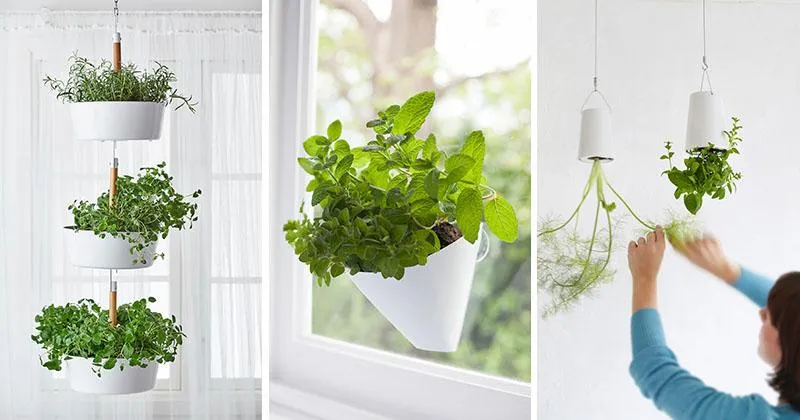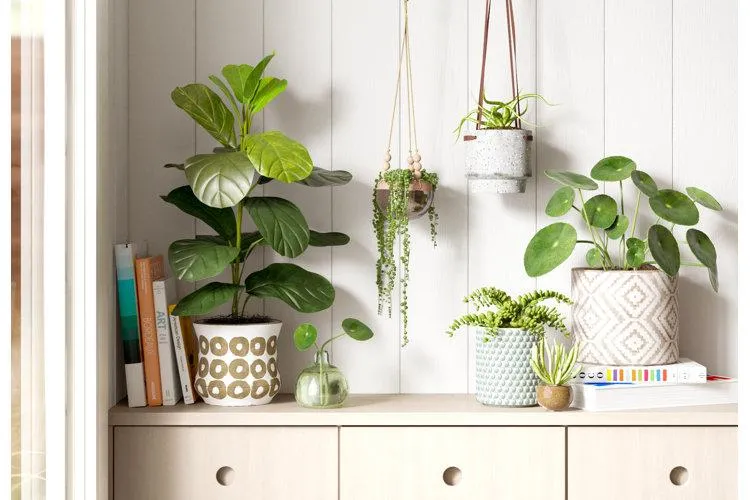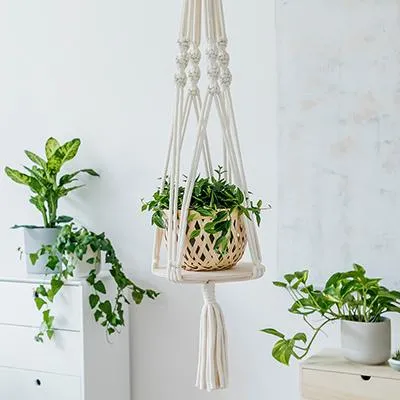A Complete Guide to Hanging Plants Indoors
As avid plant parents, we’re always on the lookout for new ways to incorporate our green friends into our indoor spaces. Hanging plants are a fun and flexible option that can basically hang out anywhere – so in this guide, I’ll cover all the essentials to help you pick, care for and display hanging plants with style.
Choosing the Right Hanging Plants
- Trailing plants: Ivy, pothos and philodendron are classics that don’t mind clinging to the sides of pots. Their vines will sort of trail down effortlessly for a lush look.
- Small foliage: Ferns, peperomias and senecio are great picks with daintier leaves. They bring visual interest without hogging a ton of space.
- Flowering varieties: Begonias, orchids, and hanging baskets filled with fuchsias or petunias add an amazing pop of color when they bloom.
Kind of a pro tip: stick to plants rated for medium or low light if hanging them somewhere without a ton of sunlight streaming in, like above a kitchen table. Their leaves may sort of wilt otherwise, which is no fun for anyone.
Hanging Planters to Consider
- Macrame hangers: Homemade or purchased, these boho-style hangers in colorful fibers are a stunning way to show off trailing plants. Is that fair?
- Metal baskets: Rustic and industrial, baskets on chains add laid-back flair. Ideal for spiller plants or combos of petite foliage.
- Ceiling hangers: Innovative hangers that latch onto light fixture hooks open up hanging possibilities for spots with limited traditional hanging points.
- Clustered pots: Group mini pots together on one chain for visual impact. Gorgeous for begonias, succulents or air plants.
From my experience, ceramic and plastic are best for drainage. Wood may soak up moisture over time and kinda rot. Metal, macrame and other woven hangers look awesome but won’t allow water to escape – only use them for plants that don’t need regular watering. You feel me?
Finding the Perfect Hanging Spot
When choosing where to position hanging plants, consider…
Light: As mentioned before, trailing plants and pothos love medium to low light. Ferns prefer bright indirect light. Orchids and begonias need sunshine but not scorching direct rays. Position according to the plant type.
Traffic patterns: Hanging plants above walkways add visual interest but also risk being bonked at times. Paths with somewhat less traffic make safer spaces.
Height: Hang trailing plants so the vines can spill down only a foot or two above people’s heads. Smaller potted plants mounted higher on walls make a striking focal point.

You’ll also want to think about things like ceiling height limitations, sturdy anchoring points, and whether you need to run cables or chains out of view. I’ve had situations where cables became sort of tangled in blinds or curtains when not concealed properly. Yikes! With some planning, you can hang plants anywhere – above windows, on porch ceilings, alongside stairwells. The possibilities are endless!
Caring for Hanging Greenery
Much like their soil-bound plant sisters, hanging plants need…
Sunlight: As mentioned, position accordingly to the plant variety’s light needs. Rotate pots periodically so all sides receive indirect rays.
Water: Check soil regularly and water when the top inch feels dry. Some plants like pothos are quite hardy about drying out between waterings. Others prefer consistently moist soil.
Fertilizer: Feed container-grown hanging plants monthly in the growing season with a diluted liquid houseplant fertilizer. Or try a timed-release organic variety.
Pruning: Trim trailing vines or foliage as needed to control size and shape. You can also propagate cuttings in water or soil to multiply your plant family.
Pest prevention: Check leaves frequently for signs of pests as it may be harder to spot them on hanging plants. Isolate and treat with neem oil or insecticide sprays as needed.

With some TLC like this on the reg, your hanging plant gang will sort of thrive for seasons to come! Let me know if you need any other plant parent wisdom. I’m always down to help newbies out.
Displaying Hanging Plants with Style
Finally, decorate planters and hanging points creatively for an artistic finished look:
– Attach trailing plants to wooden hoops, carts or old window frames hung on walls.
– Cluster 3-4 small pots of different trailing plants on one chain for visual interest.
– Incorporate dangling terrariums, string art or wind chimes alongside hanging plants.
– Layer trailing plants inside hanging baskets nested together on one hook for volume.
– Use trailing plants as a natural room divider hung on either side of an arched doorway.

– Braid or twist trailing vines together and secure the plaited strands to hooks for a bohemian aesthetic.
Does adding artful greenery like this boost a space’s charm? I think so – plants have the power to basically uplift moods too. So whether you place a trailing combo above your kitchen sink or festoon a front porch with flower baskets, hanging plants are a fun way to bring nature indoors wherever you please. Who knows, maybe the creative process will spark some other crafty ideas!
In conclusion, I hope this guide has sparked your curiosity to experiment more with hanging plants. They’re low maintenance houseplant companions that also just make placing foliage way more flexible indoors. Let me know if you have any other questions arise! I’m always around for more plant chat.
Factors to Consider When Choosing Hanging Plants for Indoor Use
| Plant | Light Needs | Watering Needs | Size |
|---|---|---|---|
| Pothos | Low | Allow soil to dry between waterings | Trailing vines up to 6 feet |
| Spider Plant | Medium | Water when top inch of soil is dry | Leaves 6-12 inches |
| Philodendron | Medium to low | Water when top inch of soil is dry | Leaves 6-12 inches |
| English Ivy | Low to medium | Water when top inch of soil is dry | Trailing vines up to 10 feet |
| Peperomia | Medium | Water when top inch of soil is mostly dry | Leaves 2-6 inches |
FAQ
-
What types of plants work best for hanging indoors?
There are basically a few kinds of plants that do very well when hung indoor. Pothos, philodendron, spider plants, and English ivy are all pretty simple varieties that don’t require much care. Plants like these can hang in almost any spot in your home.
-
How do I care for hanging plants?
Caring for hanging plants is kinda similar to regular potted plants. Water them when the soil is dry to the touch, about once every 7 to 10 days. Feed them monthly in the spring and summer with a diluted liquid plant food. Also, hang ’em in a spot that gets at least six hours of indirect sunlight every day. Seems simple enough, right?
-
What is the best pot to use for hanging baskets?
Pots made for hanging plants work well since they have holes in the bottom for drainage. Plastic or terra cotta pots tend to work great. However, you can get artistic and use baskets, glass containers, or other decorative planters too. Maybe drill drainage holes in those if needed. On the other hand, avoid using pots without holes or the soil can get soggy.
-
How do I hang pots indoors?
There are various ways to hang indoor pots. Command strips can hold lightweight pots but might only work for a few months. Alternatively, tying string or rope from ceiling hooks or trellises provides a simple solution. For heavier pots, use brackets or chains screwed securely into wall studs or ceiling beams. Is that safe enough? You wouldn’t want a heavy plant to come crashing down!

-
What kinds of hooks or hardware do I need?
For hanging indoor plants, you’ll need some type of hardware like small hooks, chains, or straps. Some ceiling hooks can hold up to 20 pounds so check the weight ratings. Stainless steel holds up better than other metals. Perhaps eye hooks screwed into wall studs give extra support. Seems the choices are endless – say, what’s your favorite way to hang plants? I’m always looking for new ideas!
-
How often do I need to rotate hanging baskets?
Most hanging basket plants will do fine without rotating. However, it kinda makes sense to spin them around every few weeks so all sides grow evenly. This ensures the plant doesn’t lean toward the light source. When you do water it, gently swivel the pot too to keep it balanced. With some care like that, your hanging garden should stay handsome for months to come!
-
Is there a limit to how many hanging plants I can have?
As long as you have enough lighting, no there’s no set limit on hanging plant numbers. However, weighing safety and whether the space can hold them is important. Perhaps start with just a few baskets and phase in more as needed. Estimate the total weight load for ceilings or walls too. On the other hand, if arranged with creativity, a large hanging display can be stunning! So enjoy your green tower to the max.
